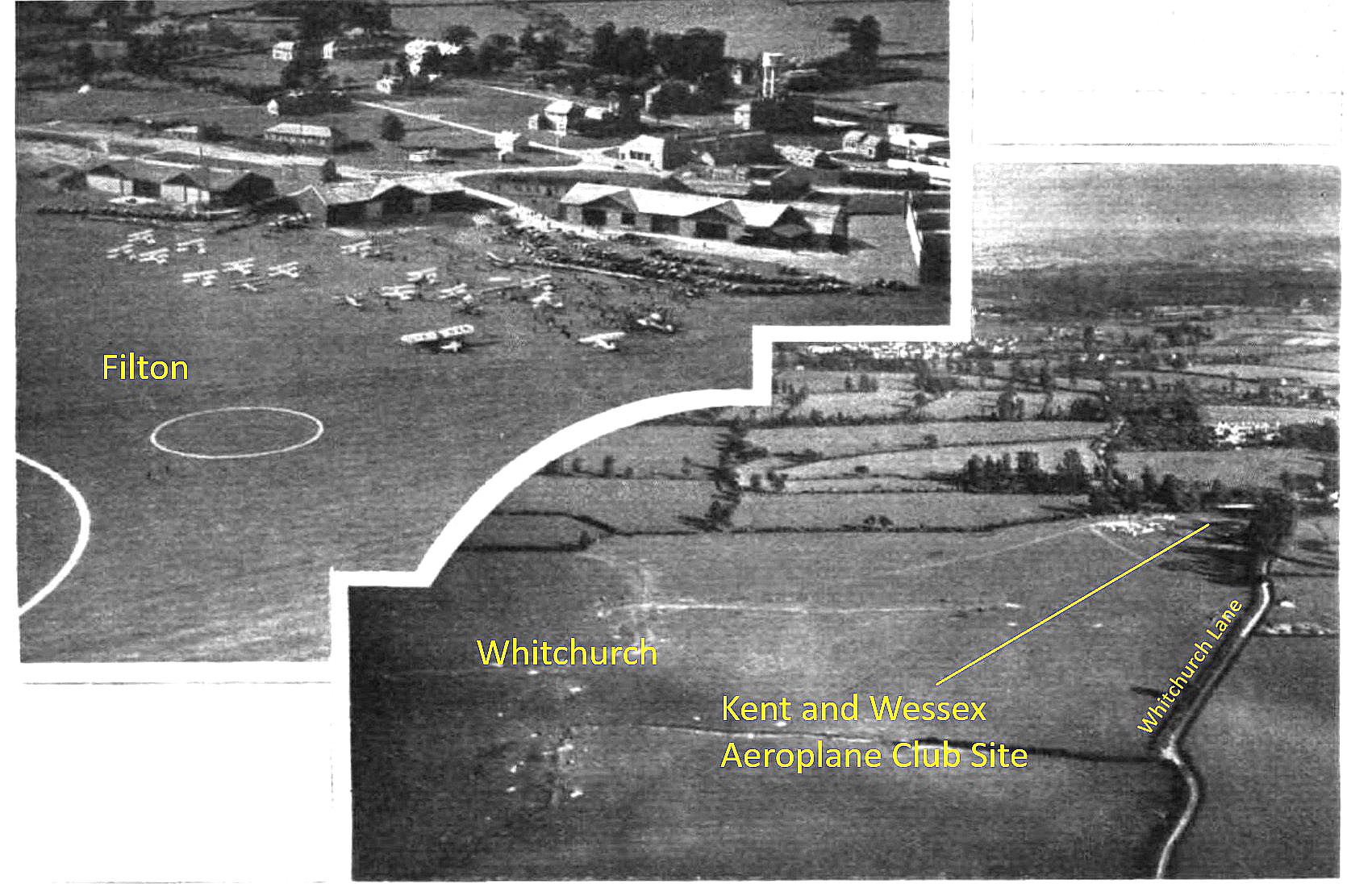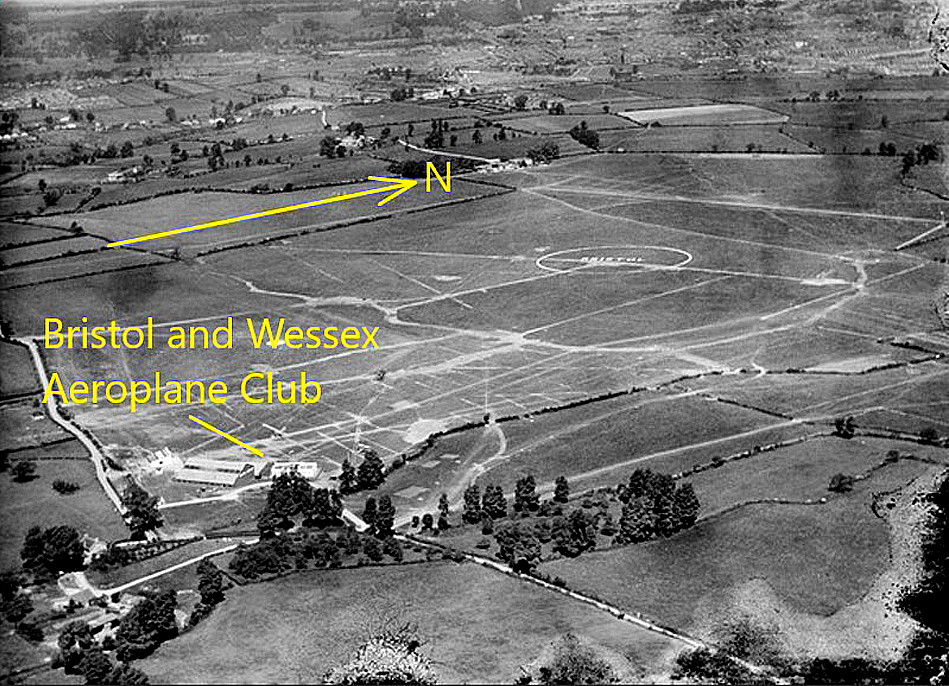Whitchurch
WHITCHURCH: Civil regional airport, later WW2 military aerodrome, then reverting back shortly as a regional airport before LULSGATE took over. (In 1934 known as WHITCHURCH AERODROME and BRISTOL AIRPORT). On modern maps spelt Whitechurch
Note: This 2018 picture of the WHITCHURCH airport site was obtained from Google Earth ©
Unless I am very much mistaken, the eastern half of runway 08/26 can still be clearly seen.
Operated by: 1933: The Bristol & Wessex Aero Club Ltd on behalf of Bristol Corporation
WW2: Apparently used by the Gloucester Aircraft Co? Also used on behalf of BOAC later in WW2?
Military user: WW2: US Army Air Corps
British airline users: Pre 1940: British Air Navigation, Channel Air Services, Crilly Airways, Great Western & Southern Air Lines, Imperial Airways, Railway Air Services, Norman Edgar (Western Airways) Ltd*
Post 1945: ?
Foreign airline users: Pre 1945: Aer Lingus
Post 1945: Aer Lingus
Flying Club: Pre 1939: The Bristol and Wessex Aeroplane Club
Note: In the 1957 The Aeroplane directory, Bristol and Wessex Aeroplane Club were operating; Three Austers, two de Havlland DH89A Tiger Moths and two Percival Proctors.
Maintenance: Pre 1939: Airwork (during WW2 too?)
Location: 3nm S of Bristol City centre, S of the A1174 and N of Whitcurch Lane
Period of operation: 1930 to 1957
Runways: When opened for initial operations in 1929 the area was 298 acres
1933: Max landing run: 878 grass
1955: 10/28 929x46 hard NE/SW 875 grass
NW/SE 933 grass
NOTES: In the 1920s and 1930s the interval between an aerodrome being first used and a Municipal authority declaring it officially open as a regional ‘airport’ facility was usually between one and two years. These were all grass airfields (intended to be used as airports in modern parlance), and often a great deal of preparation was required. Indeed, at least two companies specialised in the ‘construction’ and preparation of grass airfields and I imagine the RAF (c/o Ministry of Supply or equivalent) were their major client?
Information published by the ARG (Airfield Research Group) reveals that apart from Norman Edgar & Co having a presence here, in 1933 at least it appears Airwork Ltd and Philips & Powis Ltd were involved. It is often overlooked today that until after WW2 the Miles Aircraft Company did not exist and most of the classic Miles designs were created when F G Miles, (ably assisted by his wife it seems), was the Chief Designer for Phillips & Powis. In the ARG listing for 1933 it states that only one hangar existed.
A MICHAEL T HOLDER GALLERY
THE OFFICIAL OPENING
It is said the arrival of the Aviation Tours ‘Tour of Britain’ fleet on the 31st May 1931 marked the official opening of this Municipal Airport for Bristol although it is plainly shown as an aerodrome as opposed to just a landing ground on a 1930 Ordnance Survey Aviation Map.
THE FIRST AIR SERVICE?
*For clarification this ‘air ferry service’ was initially operated by Norman Edgar & Co from Cardiff (presumably from PENGHAM MOORS/SPLOTT FORESHORE) using the DH Fox Moth G-ABYO, starting on the 26th September 1932. Nearly a year later, on the 7th September 1933, the company name was changed to Norman Edgar (Western Airways) Ltd.
THINGS GOT GOING
It is stated that in the first year of operation, (1931?), the ‘airport’ handled just 915 passengers but this had risen to 4,000 by the next year. From the start it seems there were air-taxi services providing regular services to Cardiff, (presumably PENGHAM MOOR?), and Torquay and Teignmouth, (presumably both served by HALDON?). By 1934 the route system had extended to Plymouth, (ROBOROUGH), Birmingham, (CASTLE BROMWICH), London, (where?), Southampton, (ATLANTIC PARK/EASTLEIGH) and Liverpool, (SPEKE).
From the 29th July to the 29th September 1934 Railway Air Services operated a DH.84 Dragon (probably G-ACVD?) on a Birmingham (CASTLE BROMWICH) – Bristol – Southampton (EASTLEIGH) – Cowes (COWES WEST) service.
A new terminal was opened in 1935. From 1937 a service was opened from Cardiff, (PENGHAM MOOR?), via WHITCHURCH to Le Touquet and onto Le Bourget (Paris). I have long been aware when landing at Le Touquet that I’ve been landing on ‘hallowed grounds’ regarding British aviation history. But, until doing the research for this Guide, had no idea the history extended into the pre-WW2 period.
A SMALL MENTION
It appears that in the 1930s Ms Pamela Wills had a De Havilland DH87B Hornet Moth based here, which she regularly flew. I think it is often forgotten that many women, (able to afford it of course), were very active as pilots during this period, and several went on the become globally acclaimed for their remarkable pioneering achievements. I wonder what exactly has happened since WW2 and surely this needs to be explained. In recent years there has of course been entry paths for women into commercial and military flying, and quite a few have opted for these careers. However, in GA for some reason, there seems to be a distinct lack of women wanting to fly. Why?
A FLYING CIRCUS VENUE
WHITCHURCH was a popular venue with the ‘flying circus’ brigade:
In June 1931 the C.D. Barnard Air Tours ‘Tour of Britain’ fleet arrived
Venue May/June 1932 for the Modern Airways “The Crimson Fleet” UK Tour
Venue 4th June 1932 for Alan Cobham’s National Aviation Day UK Display Tour
Venue (16th June 1934) for Alan Cobham’s 1934 Tour of the UK
Venue (18th August 1934) for the Sky Devils Air Circus Tour of the UK
Venue (25th May 1936) for British Empire Air Display Tour of the UK
THE WW2 PERIOD
Early in WW2 Imperial Airways and British Airways ‘decamped’ their landplanes from CROYDON, (the Imperial Airways flying boats went to POOLE in DORSET)an eventuality that had been very carefully planned and took just two days to accomplish. Part of the operation also went to EXETER (DEVON) and HENDON (LONDON) under the NAC (National Air Communications) organisation.
It seems that in early WW2 at least this was a BOAC “A” base so this presumably was the period when Imperial Airways, (and British Airways?), amalgamated to became BOAC. Escapee types such as KLM DC2s & DC3s probably came here too as well as to HENDON.
It would also appear the Bristol Aircraft Company both stored and assembled Beaufighters here. Other Bristol types too perhaps?
Simon Wood
This comment was written on: 2018-06-13 07:13:24Excellent piece on Whitchurch Airport. Could you please tell me when the runways changed to asphalt. Many thanks.
Reply from Dick Flute:
Hi Simon, I do not know exactly, but almost certainly during WW2 and probably from 1942 on? Perhaps somebody can kindly offer advice. Best regards, Dick
Paula Masters
This comment was written on: 2020-05-06 12:59:51According to his R.A.F. flying log, my father, Thomas (Tommy) Gibbs was seconded from R.A.F. to B.O.A.C. Bristol 1.8.44and first flew Dakota C.47 from Whitchurch to Watchfield on September 12th 1944 with Capt. Tagart (Taygart?) and F/Lt. Bailey and many more flights from Whitchuch. He joined B.E.A. on1.8.46.
Dick Flute
This comment was written on: 2020-05-06 18:44:11Hi Paula, What an amazing coincidence. I had an uncle, also Tommy Gibbs, who flew with the RAF in WW2, and briefly joined BOAC before transferring to BEA when that was formed. Best regards, Dick
We'd love to hear from you, so please scroll down to leave a comment!
Leave a comment ...
Copyright (c) UK Airfield Guide






















